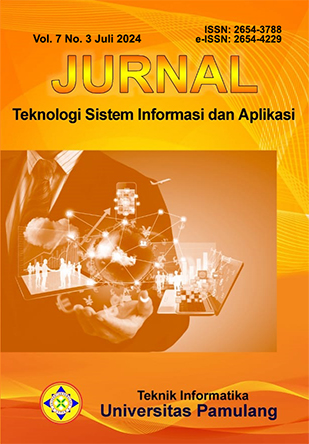Perancangan Alat Latihan Tinju Pengukur Jumlah Pukulan dan Kekuatan Pukulan Berbasis Internet of Things (IoT)
DOI:
https://doi.org/10.32493/jtsi.v7i3.42001Kata Kunci:
Tinju; Piezoelektrik; Internet of ThingsAbstrak
Menjaga kesehatan fisik penting dilakukan, salah satunya dengan berolahraga. Tinju menjadi olahraga yang dapat dipilih karena selain dapat menjaga kebugaran, juga sebagai bentuk pertahanan diri dengan mengandalkan kemampuan pukulan. Sebelumnya telah dilakukan pengembangan alat untuk mengukur kekuatan tendangan, namun hasilnya hanya dapat dimonitoring melalui web localhost sehingga tidak dapat diakses di perangkat lain. Penelitian ini bertujuan untuk merancang alat pengukur jumlah dan kekuatan pukulan pada olahraga tinju yang dapat dipantau di mana saja melalui internet. Sehingga dirancang alat pengukur jumlah pukulan dan kekuatan pukulan menggunakan sensor piezoelektrik dengan website sebagai interface. Selain piezoelektrik, digunakan Arduino Mega, LCD, serta ESP32. Hasil pada pengujian akurasi sensor memiliki rata-rata persentase eror 5,09% dan kegagalan pengiriman data 0%. Selama 60 detik dalam 30 kali percobaan didapatkan rata-rata jumlah pukulan sebanyak 90 pukulan dan kekuatan pukulan senilai 800.
Referensi
Halomoan, Rinaldi. 2020. “Development of Samsak to Improve Technical Ability to Fight in Extracurricular Tarung Derajat in Senior High School.” 3(2):18–27.
Hardiansyah, Harry. 2023. Pengembangan Alat Pengukur Kekuatan Tendangan Beladiri Pencak Silat Dengan Sensor Load Cell.
Harsono. 1988. Coaching Dan Aspek-Aspek Psikologi Dalam Coaching. Jakarta: Departemen Pendidikan dan Kebudayaan.
Lahinda, Jori, Carolus Wasa, and Pulung Riyanto. 2020. “Pengaruh Program Latihan Peningkatan Daya Tahan Jantung Paru Pada Ukm Tinju.” Kinestetik 4(1):7–13. doi: 10.33369/jk.v4i1.10257.
Malaric, Roman. 2011. Instrumentation and Measurement in Electrical Engineering. Boca Raton: Universal-Publishers.
Novaliendry, Dony, Asrul Huda, Muhammad Rinov Cuhanazriansyah, Hesty Kumala Sani, Herisvan Hendra, and Joni Karnando. 2021. “E-Learning Based Web Programming Course in the COVID 19 Pandemic Time.” International Journal of Interactive Mobile Technologies 15(20):117–30. doi: 10.3991/ijim.v15i20.23749.
Pendra, Aldi. 2020. “Perancangan Alat Ukur Kekuatan Tendangan Berbasis Mikrokontroler Untuk Monitoring Perkembangan Latihan Pesilat.” Jurnal Berkala Epidemiologi 5(1):90–96.
Seta, Satrio Bayu, and Wijono. 2021. “Analisis Frekuensi Pukulan Dalam Pertandingan Tinju Profesional.” Jurnal Prestasi Olahraga 4(3):144–50.
Setyawan, Risfandi. 2022. Mengenal Pelatihan Kondisi Fisik Level Dasar. Vol. 1. I. edited by Indah. Sukabumi: Haura Utama.
Sholihin; Nurjaya; Ardhiansyah, Maulana. 2022. Membangun Web Dengan Framework Laravel 8. edited by T. Hidayati. Tangerang Selatan: Pascal Books.
Sumarjo, Sumarjo. 2022. “Hambatan-Hambatan Cabang Olahraga Tinju Di Kabupaten Pidie.” Jurnal Real Riset 4(2):277–87. doi: 10.47647/jrr.v4i2.677.
Trimarsiah, Yunita. 2024. “Pelatihan Pembuatan Website Pada Kantor Kelurahan Talang Jawa Baturaja Sumatera Selatan.” Jurnal Pengabdian Bersama Masyarakat Indonesia 2(1):09–22.
Unduhan
Diterbitkan
Cara Mengutip
Terbitan
Bagian
Lisensi
Hak Cipta (c) 2024 Annisa Ul Alliya, Lindawati Lindawati, Eka Susanti

Artikel ini berlisensi Creative Commons Attribution-NonCommercial 4.0 International License.
Authors who publish with this journal agree to the following terms:
- Authors retain copyright and grant the journal right of first publication with the work simultaneously licensed under a Creative Commons Attribution License that allows others to share the work with an acknowledgement of the work's authorship and initial publication in this journal.
- Authors are able to enter into separate, additional contractual arrangements for the non-exclusive distribution of the journal's published version of the work (e.g., post it to an institutional repository or publish it in a book), with an acknowledgement of its initial publication in this journal.
- Authors are permitted and encouraged to post their work online (e.g., in institutional repositories or on their website) prior to and during the submission process, as it can lead to productive exchanges, as well as earlier and greater citation of published work (See The Effect of Open Access).
Jurnal Teknologi Sistem Informasi dan Aplikasi have CC BY-NC or an equivalent license as the optimal license for the publication, distribution, use, and reuse of scholarly work.
In developing strategy and setting priorities, Jurnal Teknologi Sistem Informasi dan Aplikasi recognize that free access is better than priced access, libre access is better than free access, and libre under CC BY-NC or the equivalent is better than libre under more restrictive open licenses. We should achieve what we can when we can. We should not delay achieving free in order to achieve libre, and we should not stop with free when we can achieve libre.
This work is licensed under a Creative Commons Attribution-NonCommercial 4.0 International (CC BY-NC 4.0) License
YOU ARE FREE TO:
- Share - copy and redistribute the material in any medium or format
- Adapt - remix, transform, and build upon the material for any purpose, even commercially.
- The licensor cannot revoke these freedoms as long as you follow the license terms



_2020_-_7(2)_2024_-_Thumbnail.png)












